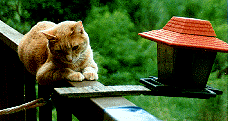MISSISSIPPI RIVER TIDBITS
"Kitty," "Kitty,"
"Kitty"-
A Case of Dr. Jekyll and Mr. Hyde

by Ruth Nissen, Wisconsin DNR
[Please Click Banner
Below to Visit our Sponsor!]

T
hat kitty sleeping in the sun in the window, curled up in the middle of the
bed or chasing that bit of yarn rolled up in a ball may be hard to picture as a ruthless
predator, but that is just what happens when "kitty" goes outdoors. Many cat
owners want their cat to kill the mice or chipmunks around the yard or barn, and indeed,
these "trophies" may be what they find on their doorstep in the morning, but
unfortunately "kitty" is also killing other animals. Trophies represent only 50%
of what cats actually kill. In addition to the rats, mice and rabbits that homeowners
frequently regard as pests, prey items include native songbirds and other mammals.
Rural cats do the most damage because they have access to the most wildlife but urban and
suburban cats add to the toll. The term "Rural," however includes the cats that
live in homes on the edge of town, homes nestled into secluded valleys, and new housing
developments in the countryside, as well as farms. These types of housing situations are
rapidly increasing along the Mississippi River and throughout the Coulee region, as people
(and their cats) move away from town to live closer to nature, or to enjoy the peace and
quiet in addition to a spectacular view. Recent research suggests that rural free-ranging
domestic cats in Wisconsin may be killing between 8 and 217 million birds each year.
This time of year the threat to birds is increased as nesting birds and the recently
fledged young are vulnerable. Cats can kill a lot of eastern meadowlarks, bobolinks, song
sparrows, and other ground nesting birds, or birds that feed on the ground like robins.
Many of the ground
nesters are grassland birds that have become "species of concern" because of
severely diminishing numbers due to loss of habitat.
Studies have shown that nearly all free-ranging cats, no matter how well-fed are effective
predators. A well-fed cat merely eats less of what it kills. However, well-fed, neutered
females are more likely to stay close to "home" and thus provide rodent control
in your yard rather than doing their kifling in a nearby wild area.
Handicapping Seldom Succeeds
- Many cat owners who are also wildlife appreciators have tried a variety of techniques to
handicap the cat in the eternal battle between cats and birds. Unfortunately it is hard to
deter a determined cat! Bells on the cat's collar do not alert birds to the presence of a
predator. Only birds who have survived an attack by a cat wearing a bell are likely to
recognize the tiniding sound as dangerous. In addition, many resourceful cats learn to
stalk quietly even while wearing a beli. Declawing a cat may help to prevent damage to
furniture, but many cats are very adept at catching prey even without claws. They merely
bat the bird down with their paw and grab it with their teeth. Neither does severe
scolding nor spanking deter a cat from hunting birds, they merely do it when the owner
isn't around. In this case "Tweety" is definitely at a disadvantage.
 The only reliable method of prevention is to keep the cat
indoors. It is a difficult dilemma facing every cat owner that moves to the country
because they appreciate watching wildlife. But this method also insures that your pet
won't be affected by unwanted reproduction, reduces cat fights, injuries, and disease, and
keeps your pet from being struck by an automobile. An excellent publication "Cats and
Wildlife- A Conservation Dilemma," available at county Extension offices, reviews the
far reaching impacts that uncontrolled predation from cats poses on wildlife and offers
suggestions on how to minimize the effects of cats if they cannot be kept indoors.
The only reliable method of prevention is to keep the cat
indoors. It is a difficult dilemma facing every cat owner that moves to the country
because they appreciate watching wildlife. But this method also insures that your pet
won't be affected by unwanted reproduction, reduces cat fights, injuries, and disease, and
keeps your pet from being struck by an automobile. An excellent publication "Cats and
Wildlife- A Conservation Dilemma," available at county Extension offices, reviews the
far reaching impacts that uncontrolled predation from cats poses on wildlife and offers
suggestions on how to minimize the effects of cats if they cannot be kept indoors.
Cats are not "bad" because they follow their predatory instinct. It is a
question of the balance of nature. Cats have become a predator that is not subject to the
limit on numbers that nature imposes on other native predators. In some parts of rural
Wisconsin cats are several times more abundant that all mid-sized native predators (such
as fox, racoon and skunks) combined. Nature no longer controls housecat numbers only cat
owners can.
Recommendations for Minimizing Cat Impact
Some recommendations from "Cats and Wildlife- A Conservation
Dilemma" for concerned cat owners on how to minimize the impacts of cats on
wildlife.
· Keep your pet cat indoors if at all possible.
· Don't support anymore cats than you need for companionship or pest control and do what
you can to minimize their time outdoors.
· Spay and neuter your cats to keep numbers down.
· Don't dispose of unwanted cats by releasing them in rural areas or in wild areas.
· Don't feed stray cats.
|
Return to top of page |
This is part of an ongoing series about the plants, fish, wildlife and
issues pertaining to the Mississippi River. For questions or comments, write to
Mississippi River Tidbits, Wisconsin DNR, State Office Bldg., Rm. 104,3550 Mormon Coulee
Rd., La Crosse, WI 54601

